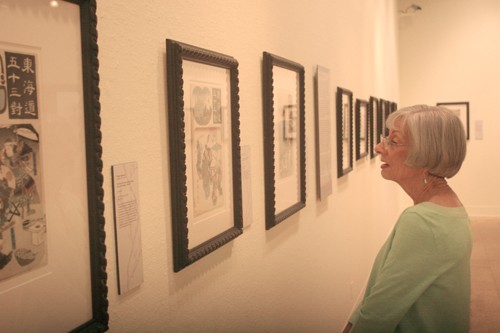Japanese artists who worked in the medium of woodblock prints during the 19th century might be surprised to see their work on display in modern art galleries.
Like other commercial artists, they worked on commissions that were intended for people who couldn’t afford such fine art as brush-and-ink paintings, calligraphy or ceramics. It was meant to help provide a source of income for the artist and his publisher, similar to the bargain coffee table books sold through chain bookstores. These works were intended for mass consumption by a general audience.
The University of Arizona Museum of Art’s current exhibition, “”Pictures of The Floating World: Life in 19th Century Japan,”” succeeds in revealing what this audience would have enjoyed and experienced in their everyday lives. The exhibition focuses on ukiyo-e prints, a genre of woodblock prints that originally showed the transience of the human world for Buddhists but later became more secular with a positive focus on the pleasure and theater districts of the city.
Befitting this change, one of the main subjects for a ukiyo-e artist was women. “”Pictures of The Floating World”” features examples of women in kimonos with strong colors and striking patterns that reflect their social standing. Keisai Eisen’s “”Courtesans Along the Tokaido: Mariko: The Teahouse”” shows a woman with a blue, floral patterned kimono sitting on a bench outside a teahouse. She looks relaxed in her S-shaped pose, with one sleeve revealing her right arm. Her body dominates the print, with nothing to distract the viewer from her clothes and form.
Ukiyo-e artists also featured famous kabuki actors of the day in their prints, displaying them similarly to a photograph on the front of People magazine. Utagawa Kunisada’s “”Kataoka Ichizo I as Tagohei”” showcases a renowned actor dressed up for a famous role.
The actor’s face is created with sharp, angular and simple lines while the intense hues accentuate his intense expression and his decorative kimono.
The second half of the 19th century was a turbulent time of change in Japan after Commodore Matthew Perry of the U.S. Navy forcefully ended the country’s seclusion and opened its ports to Western countries in 1853. As a result, the Japanese population saw more foreigners, which is represented in the exhibition by Utagawa Yoshikazu’s 1861 piece, “”An American Couple.””
Many Japanese patrons also sought art that presented a romantic and idyllic era or pleasurable distractions, and ukiyo-e artists were willing to provide it. Ando Hiroshige’s “”The 53 Stations of the Tokaido: #46 Shono”” is from a popular series of prints based on the artist’s travels along the road that connects Tokyo and Kyoto. This particular image depicts laborers running through the rain. They are hunched over and running along a diagonal that accentuates the slanted lines of rain and the trees bent by the wind. These elements create an effect of static movement. Another print of the same series, “”#24 Shimada,”” also zigzags its way through a landscape, but instead of the frenzy of running through rain, it shows travelers being transported across the river. By presenting the scene in a vertical format, the procession gently recedes into the mountain as if they were returning to nature.
“”Pictures of The Floating World: Life in 19th Century Japan”” does a wonderful job of providing an overview of Japanese life during a time of change, and it serves as a good introduction to ukiyo-e prints. Imagine how the woodblock artists would react if they saw their art on display today.









